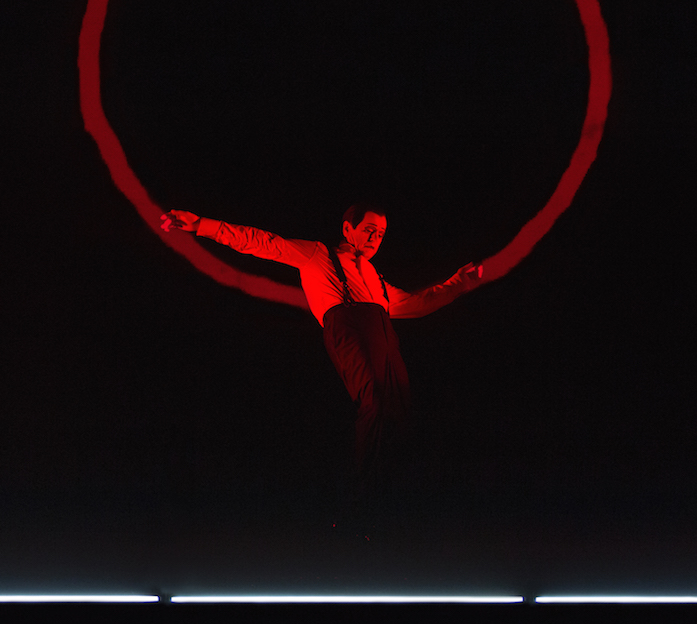
A love letter danced across time
Most dance aficionados would be willing to sacrifice a molar just to watch Mikhail Baryshnikov walk across a stage. However, Cal Performances made it possible for us to see this extraordinary dancer without undue sacrifice this past weekend. And true to expectation, Baryshnikov was riveting in every gesture.
Letter to a Man places the incomparable dancer in the role of Vaslav Nijinsky, another superlative dancer, who through his extraordinary vision as a choreographer changed the face of ballet in the early 20th century. And through the intensely poetic prose of his diary changed the face of modernism as a force for revolutionary art.
Letter to a Man is a theatrical collaboration between Baryshnikov and Robert Wilson, who designed and directed the piece. The lighting and staging are characteristic of Wilson – spare, elegant and stylized. The brightness of the lights on-stage borders on the invasive, and creates a world in which shadow and darkness are the bearers of meaning within the visual landscape. Silhouette is primary: the beings who haunt Nijinsky’s shattered psyche are without face, without color, and are reduced to mere volume and line, walking voids. What the piece brings to us is the encroaching madness of a sensitive and mentally fragile man – in all its terrors.
The libretto, which is in Russian and English, taken from the translation by Christian Dumais-Lvowski, extracts several passages from Nijinsky’s diaries. Each passage, composed of only a few sentences, is repeated over and over. The repetitions create an atmosphere of obsession, and even despair.
The opening scene has Baryshnikov in white-face and tails seated on a chair, his arms wrapped around him in a straight jacket. The chair is center stage in a doorway of light, which narrows the large stage down to the smallest possible unit to frame the actor. The soundtrack reports, “I understand war because I fought with my mother-in-law.” It repeats the sentence in Russian, Baryshnikov repeats the sentence in both English and Russian. Over and over, back and forth.
This line is a good place to start in the narrative. For the First World War was one of the catalysts to Nijinsky’s madness. It terrified and unraveled him, as it did many of the people of the time. Even more telling, it collided with Nijinsky’s battle with Serge Diaghilev, the brilliant impresario who founded and ran the Ballets Russes. Nijinsky, like Leonide Massine, Serge Lifar and Anton Dolin after him, was Diaghilev’s lover, a relationship Nijinsky suggests was necessary for his career. When Nijinsky left Diaghilev to marry the aristocrat Romola de Pulszky, Diaghilev turned every ounce of his vindictive powers to undo Nijinsky’s attempts at independence.
A cultured man from a wealthy family, Diaghilev worked with Artistic Director Leon Bakst to create some of the most daring works of the early 20th century. He commissioned works from Debussy, Rimsky-Korsakov, Ravel, da Falla. But most crucially of all, from Igor Stravinsky.
Diaghilev also worked with and cultivated the most famous dancers of his time, Pavlova, Karsavina, and later George Balanchine and de Valois, among many others. And he worked with some of the most brilliant visual artists of the time. His taste was without peer. And he kept the Ballets Russes and its remarkable and radical ventures afloat, albeit tenuously, for some 20 years.
The man in the title Letter to a Man is Diaghilev, but his name doesn’t appear in the piece until quite late in the performance. But he is the “you” that haunts the text in the last 15 minutes of the production: the you who “knows how to pretend,” the you who “means me harm,” the you who is “a spiteful man.”
Baryshnikov doesn’t dance ballet in Letter to a Man, he simply moves – walks, runs, stretches, repeating steps and gestures, but he translates every move into something that is fundamentally dance. Although the choices of text and scene emphasize madness, ignoring in some indefinable way the poetry of Nijinsky’s tender mind, it is through Baryshnikov’s movements that the gentleness and sweetness of the stricken dancer are conveyed. Letter to a Man would not have not reached Nijinsky’s essential beauty without him.
– Jaime Robles
Photo: Mikhail Baryshnikov in Letter to a Man, based on the diary of Vaslav Nijinsky. The latest production in Cal Performances’ RADICAL Innovation series. Photo by Lucy Jansch.
